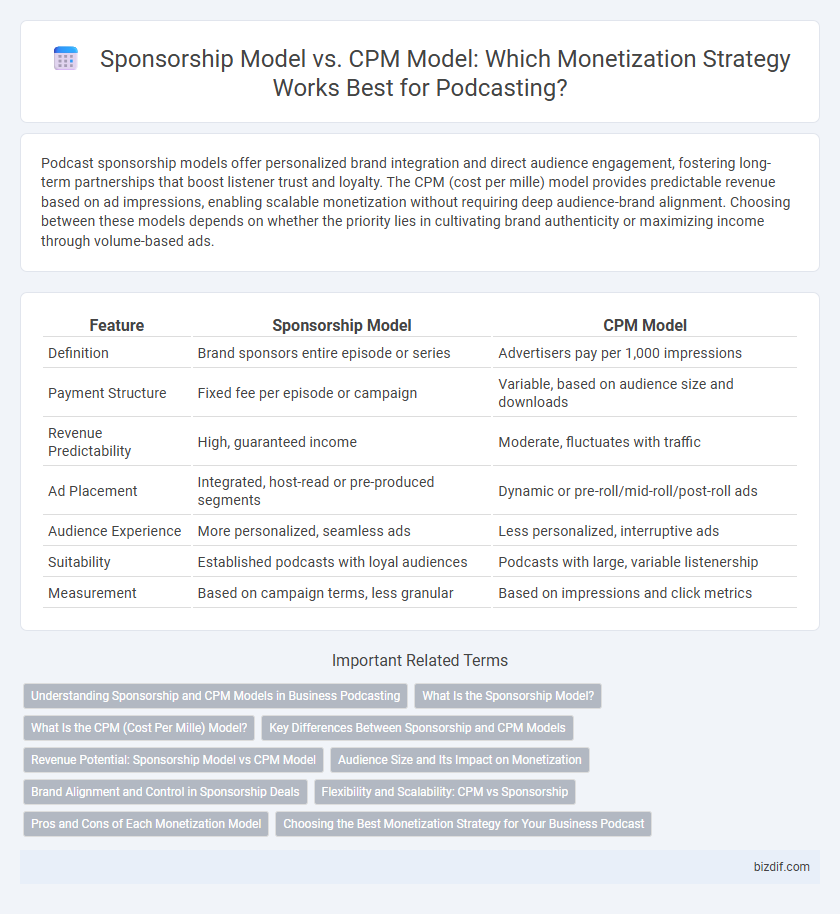Podcast sponsorship models offer personalized brand integration and direct audience engagement, fostering long-term partnerships that boost listener trust and loyalty. The CPM (cost per mille) model provides predictable revenue based on ad impressions, enabling scalable monetization without requiring deep audience-brand alignment. Choosing between these models depends on whether the priority lies in cultivating brand authenticity or maximizing income through volume-based ads.
Table of Comparison
| Feature | Sponsorship Model | CPM Model |
|---|---|---|
| Definition | Brand sponsors entire episode or series | Advertisers pay per 1,000 impressions |
| Payment Structure | Fixed fee per episode or campaign | Variable, based on audience size and downloads |
| Revenue Predictability | High, guaranteed income | Moderate, fluctuates with traffic |
| Ad Placement | Integrated, host-read or pre-produced segments | Dynamic or pre-roll/mid-roll/post-roll ads |
| Audience Experience | More personalized, seamless ads | Less personalized, interruptive ads |
| Suitability | Established podcasts with loyal audiences | Podcasts with large, variable listenership |
| Measurement | Based on campaign terms, less granular | Based on impressions and click metrics |
Understanding Sponsorship and CPM Models in Business Podcasting
Sponsorship models in business podcasting involve long-term partnerships where brands align closely with podcast content, fostering trust and brand loyalty among a targeted audience. The CPM (Cost Per Mille) model bases payment on every thousand listens or downloads, offering predictable revenue for creators but less integration with the content. Understanding these models helps podcasters optimize monetization strategies by balancing consistent income and audience engagement.
What Is the Sponsorship Model?
The sponsorship model in podcasting involves brands partnering directly with podcasters to promote products or services within episodes, often through host-read or integrated ads. This model allows for personalized and authentic messaging that resonates with the podcast's audience, leading to higher engagement and trust. Unlike the CPM (Cost Per Mille) model, which charges advertisers based on impressions, sponsorship deals focus on long-term relationships and exclusive placements, enhancing brand association with the show.
What Is the CPM (Cost Per Mille) Model?
The CPM (Cost Per Mille) model in podcasting charges advertisers based on every 1,000 ad impressions, providing a straightforward metric for campaign budgeting and reach estimation. This model is favored for its predictability and scalability, making it easier for podcasters to forecast revenue and advertisers to measure exposure. CPM rates vary widely depending on podcast niche, audience size, and engagement, often ranging from $18 to $50 per 1,000 downloads.
Key Differences Between Sponsorship and CPM Models
The sponsorship model in podcasting involves direct partnerships where advertisers sponsor entire episodes or series, often integrating branded messages naturally within the content, leading to higher audience engagement and brand affinity. In contrast, the CPM (Cost Per Mille) model charges advertisers based on the number of impressions or downloads, offering scalability and predictable budgeting but less personalized integration. Key differences include the sponsorship model's emphasis on long-term relationships and customized messaging versus CPM's focus on volume-driven ad placements and performance metrics.
Revenue Potential: Sponsorship Model vs CPM Model
The Sponsorship Model offers higher revenue potential by fostering long-term brand partnerships with customized ad integrations, leading to consistent income streams. The CPM (Cost Per Mille) Model generates revenue based on the number of ad impressions, making it scalable but often less lucrative for smaller podcasts. Podcasts with a large, engaged audience can maximize earnings through sponsorships, while CPM suits shows with high download volumes seeking straightforward monetization.
Audience Size and Its Impact on Monetization
Audience size significantly influences podcast monetization, with sponsorship models typically favoring smaller, highly engaged audiences for targeted brand partnerships. In contrast, the CPM (cost per mille) model scales effectively with larger audiences, as revenue is generated based on the number of ad impressions served. Podcasters must assess their listener base to choose between personalized sponsorship deals or volume-driven CPM advertising strategies for optimal income.
Brand Alignment and Control in Sponsorship Deals
Sponsorship models in podcasting emphasize brand alignment by allowing sponsors to collaborate closely with creators, ensuring messaging resonates authentically with the target audience. This approach grants brands greater control over content integration, enhancing credibility and listener trust compared to the CPM model, which typically prioritizes ad volume over tailored engagement. Consequently, sponsorship deals foster deeper connections between brands and listeners, driving higher conversion rates through contextual relevance.
Flexibility and Scalability: CPM vs Sponsorship
The sponsorship model offers greater flexibility by allowing advertisers to create customized, long-term partnerships tailored to a podcast's unique audience and content style. CPM (Cost Per Mille) pricing scales efficiently with audience growth, providing predictable revenue based on impressions but often limits personalization and engagement opportunities. Podcasts with rapidly expanding audiences benefit from CPM scalability, while niche shows gain more value through flexible sponsorship agreements.
Pros and Cons of Each Monetization Model
The Sponsorship Model in podcasting offers personalized brand integration and higher revenue per episode but may limit creative freedom and require long-term commitments with advertisers. The CPM (Cost Per Mille) Model provides predictable income based on audience size and easier scalability across multiple advertisers but often yields lower payouts and less audience targeting precision. Choosing between these models depends on balancing control, revenue potential, and advertiser relationships to optimize monetization strategies.
Choosing the Best Monetization Strategy for Your Business Podcast
Sponsorship Model offers direct partnerships with brands, providing tailored advertisements that align with your podcast's niche, leading to higher audience engagement and potentially long-term relationships. In contrast, the CPM Model pays per thousand listens, ensuring consistent revenue based on download metrics but often at lower rates and less customization. Evaluating your podcast's audience size, brand alignment, and revenue goals will help determine whether sponsorships or CPM-based ads maximize your monetization strategy.
Sponsorship Model vs CPM Model Infographic

 bizdif.com
bizdif.com